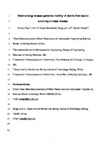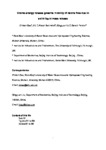Grain‐energy release governs mobility of debris flow due to solid–liquid mass release
| dc.contributor.author | Cao, Zhixian | |
| dc.contributor.author | Li, J | |
| dc.contributor.author | Borthwick, Alistair | |
| dc.contributor.author | Liu, Qingquan | |
| dc.contributor.author | Pender, G | |
| dc.date.accessioned | 2021-08-22T11:02:27Z | |
| dc.date.available | 2021-08-22T11:02:27Z | |
| dc.date.issued | 2020-09-30 | |
| dc.identifier.issn | 0197-9337 | |
| dc.identifier.issn | 1096-9837 | |
| dc.identifier.uri | http://hdl.handle.net/10026.1/17651 | |
| dc.description.abstract |
<jats:title>Abstract</jats:title><jats:p>Debris flows often exhibit high mobility, leading to extensive hazards far from their sources. Although it is known that debris flow mobility increases with initial volume, the underlying mechanism remains uncertain. Here, we reconstruct the mobility–volume relation for debris flows using a recent depth‐averaged two‐phase flow model without evoking a reduced friction coefficient, challenging currently prevailing friction‐reduction hypotheses. Physical experimental debris flows driven by solid–liquid mass release and extended numerical cases at both laboratory and field scales are resolved by the model. For the first time, we probe into the energetics of the debris flows and find that, whilst the energy balance holds and fine and coarse grains play distinct roles in debris flow energetics, the grains as a whole release energy to the liquid due to inter‐phase and inter‐grain size interactions, and this grain‐energy release correlates closely with mobility. Despite uncertainty arising from the model closures, our results provide insight into the fundamental mechanisms operating in debris flows. We propose that debris flow mobility is governed by grain‐energy release, thereby facilitating a bridge between mobility and internal energy transfer. The initial volume of debris flow is inadequate for characterizing debris flow mobility, and a friction‐reduction mechanism is not a prerequisite for the high mobility of debris flows. By contrast, inter‐phase and inter‐grain size interactions play primary roles and should be incorporated explicitly in debris flow models. Our findings are qualitatively encouraging and physically meaningful, providing implications not only for assessing future debris flow hazards and informing mitigation and adaptation strategies, but also for unravelling a spectrum of earth surface processes including heavily sediment‐laden floods, subaqueous debris flows and turbidity currents in rivers, reservoirs, estuaries, and ocean. © 2020 John Wiley & Sons, Ltd.</jats:p> | |
| dc.format.extent | 2912-2926 | |
| dc.language | en | |
| dc.language.iso | en | |
| dc.publisher | Wiley | |
| dc.subject | debris flows | |
| dc.subject | solid-liquid mass release | |
| dc.subject | high mobility | |
| dc.subject | mobility-volume relation | |
| dc.subject | energy transfer | |
| dc.subject | grain-energy release | |
| dc.title | Grain‐energy release governs mobility of debris flow due to solid–liquid mass release | |
| dc.type | journal-article | |
| dc.type | Journal Article | |
| plymouth.author-url | https://www.webofscience.com/api/gateway?GWVersion=2&SrcApp=PARTNER_APP&SrcAuth=LinksAMR&KeyUT=WOS:000548729400001&DestLinkType=FullRecord&DestApp=ALL_WOS&UsrCustomerID=11bb513d99f797142bcfeffcc58ea008 | |
| plymouth.issue | 12 | |
| plymouth.volume | 45 | |
| plymouth.publication-status | Published | |
| plymouth.journal | Earth Surface Processes and Landforms | |
| dc.identifier.doi | 10.1002/esp.4939 | |
| plymouth.organisational-group | /Plymouth | |
| plymouth.organisational-group | /Plymouth/Faculty of Science and Engineering | |
| plymouth.organisational-group | /Plymouth/Faculty of Science and Engineering/School of Engineering, Computing and Mathematics | |
| plymouth.organisational-group | /Plymouth/Users by role | |
| plymouth.organisational-group | /Plymouth/Users by role/Academics | |
| dc.identifier.eissn | 1096-9837 | |
| dc.rights.embargoperiod | Not known | |
| rioxxterms.versionofrecord | 10.1002/esp.4939 | |
| rioxxterms.licenseref.uri | http://www.rioxx.net/licenses/all-rights-reserved | |
| rioxxterms.type | Journal Article/Review |



